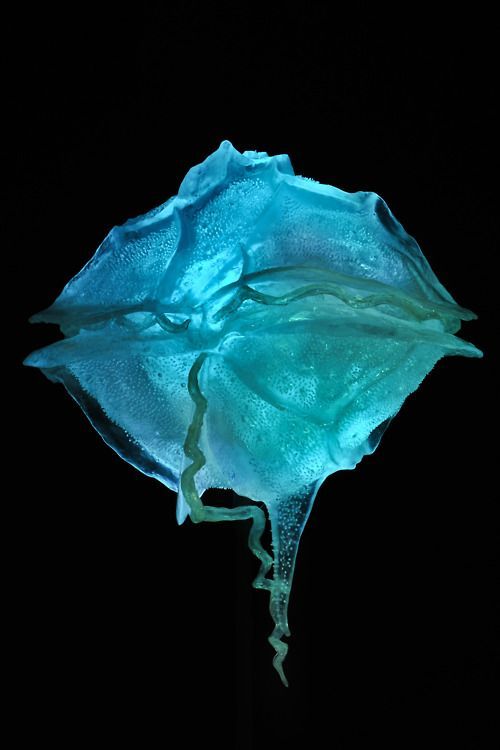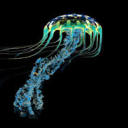Glasshead Grenadier

Glasshead Grenadier
Hymenocephalus italicus
The Glasshead Grenadier is a small deep sea fish named due to a transparent memberane that covers its head. It has fragile head bones, and it feeds on surface copepods and crustaceans. This fish is located between 100 m to 2000 m in the ocean.
Photo credit: https://www.fishbase.se/summary/1720
https://www.futura-sciences.com/planete/photos/oceanographie-abysses-ces-merveilles-profondeurs-40-photos-686/ocean-grenadier-vitrier-hymenocephalus-italicus-poisson-abysses-4541/
More Posts from Bioluminescentoceangoddess and Others

Pram Bug
Phronima sedentaria
The Pram Bug is a deep sea amphipod that is located between 200 to 1000m in the ocean. It has a translucent exoskeleton and can see primarily blue light. It is also is contained in a hollowed out barrel that is used for protection and to house babies. The image above is a female pram bug carrying its young.
Photo Credit:https://ocean.si.edu/ocean-life/invertebrates/phronima-female-and-young


Blacksnout Seasnail
Paralipparis copei copei
The Blacksnout Seasnail may not look like a snail, but it does have a slimy, gelatinous substance that covers its body. It can be found at depths between 200 m to 1692 m, and adults grow up to be 17 cm in size (approximately 6.5 in). It also has an elongated body that resembles an eel. Furthermore, it can be seen rolling itself in a loop; this behavior is a defensive posture that makes it appear like a jelly. In the darkness, predators tend to avoid the Blacksnout Seasnail because its often mistaken as a hunter due to its appearance and behavior.

Glass Octopus
Vitreledonella richardi
The Glass Octopus spend its entire life in the midwater section of the ocean and found at depths between 200m to 2000m. Even though it has no protection from predators, it achieves perfect transparency. The only part of the Glass Octopus that is visible is its digestive gland. However, the digestive gland is placed vertically to minimize detection. In addition, I find this octopus to be super cute!
Photo credit: https://www.mynumer.com/forums/topic/499/invisible-animals/view/post_id/859



Black Dragonfish
Idiacanthus atlanticus
The Black Dragonfish are needle-like fish that migrate between 500m and 2000m in the deep ocean. Females are black with 6 stripes and lack a barbel, pelvic fins, and sharp teeth. Males, on the other hand, are dark brown and have a barbel, which is the light producing structure on its chin. Furthermore, it uses bioluminescence to detect prey instead of lure prey.
Photo credit: https://scitechdaily.com/scientists-learn-secrets-from-ultra-black-skin-that-allows-deep-sea-fish-to-lurk-unseen/
https://steemit.com/life/@munnashah/the-most-terrible-and-surprising-7-animals-of-the-sea
https://knowyourmeme.com/photos/995601-thalassophobia





Wake up babe new fish dropped


Jewel Squid
Histioteuthis heteropsis
The Jewel Squid is covered in color-changing photophores that resemble sparkling gem stones. They also have a light-red coloration and are about 20 cm in length. They display a unique behavioral adaptation called diel migration. During the day, they stay at depths around 400-1200 m, and then surface during night (0-400m). This behavioral pattern is designed maximize feeding at night, and avoid predators during the day. The primary predator of the Jewel Squid is the Sperm Whale.
Photo credit: https://www.pinterest.com/pin/722827808920240115/
https://twitter.com/theoctonation/status/1168516522270253056


Pyrodinium bahamense
Pyrodinium bahamense is a tropical species of dinoflagellates that is found primarily in Atlantic Ocean waters. It prefers salinity around 20 psu and blooms when there are large amounts of nitrogen in the water. The dinoflagellate glows bright blue when agitated by motion. Furthermore, even though this plankton species is beautiful to look at, it causes seafood toxicity.
Photo credit: https://alchetron.com/Pyrodinium-bahamense
https://wonderchews.com/bodies-of-light/



Fangtooth
Anoplogaster cornuta
The Fangtooth is a ferocious predator that is found at depths between 600 m to 5000 m. It has large, needle like teeth that are used to catch prey. It also has extremely sensitive sensory canals underneath of its scales used to detect movement in the water. Furthermore, their preferred prey are crustaceans and fish.
Photo credit: https://pixels.com/featured/fangtooth-fish-dant-fenolio.html
https://www.pinterest.com/pin/845902742487789950/
https://www.newscientist.com/article/mg23231020-400-up-close-with-the-giant-teeth-of-the-deepsea-fangtooth/


Pigbutt worm
Chaetopterus pugaporcinus
The Pigbutt worm or the flying buttocks of the sea is spotted floating between 965 m to 1300 m in the deep ocean. It is actually a polychaete (polly-keet) worm species that burrows in the ground as an adult, and floats around the ocean as a baby. The worm feeds itself : by creating a balloon of mucus; collecting particles on the mucus; and then consuming the particles. It is the rarest and thickest worm in the deep ocean, for only ten have been spotted.
Photocredit: https://roaring.earth/pigbutt-worm/


Physonect Siphonophore
Nanomia cara
The Physonect siphonophore has tiny, bubble shaped sacs that are filled with gas. The sacs are called pneumatophores and help this creature move through the deep ocean. It also has venomous tentacles that stun prey and over eighty stomachs. There are numerous amounts of these strange creatures along the east coast, and they have cause some fisheries to collapse. Furthermore, they can be found at depth between 400m to 1000m.
Photo credit: http://www.seawater.no/fauna/cnidaria/cara.html
https://www.mindenpictures.com/stock-photo-siphonophore-hydrozoan-cnidarian-nanomia-cara-atlantic-nectophores-naturephotography-image90194961.html
-
 stardustandmoonflowers liked this · 1 year ago
stardustandmoonflowers liked this · 1 year ago -
 lemon-lime-lauren reblogged this · 1 year ago
lemon-lime-lauren reblogged this · 1 year ago -
 dragoonmagic liked this · 1 year ago
dragoonmagic liked this · 1 year ago -
 couldhavechoosensthbetter liked this · 2 years ago
couldhavechoosensthbetter liked this · 2 years ago -
 thecloudpup-blog liked this · 2 years ago
thecloudpup-blog liked this · 2 years ago -
 saltmatchescandlewax reblogged this · 2 years ago
saltmatchescandlewax reblogged this · 2 years ago -
 adventures-of-indiana-croft reblogged this · 2 years ago
adventures-of-indiana-croft reblogged this · 2 years ago -
 shortsweet2thepointe liked this · 2 years ago
shortsweet2thepointe liked this · 2 years ago -
 ilovemitski191 liked this · 2 years ago
ilovemitski191 liked this · 2 years ago -
 autokrates reblogged this · 2 years ago
autokrates reblogged this · 2 years ago -
 wretchedmaiden liked this · 2 years ago
wretchedmaiden liked this · 2 years ago -
 automationsorceress reblogged this · 2 years ago
automationsorceress reblogged this · 2 years ago -
 soft-fuzzy-communist liked this · 2 years ago
soft-fuzzy-communist liked this · 2 years ago -
 amethysthorizon reblogged this · 3 years ago
amethysthorizon reblogged this · 3 years ago -
 rhincodon-cynocephalus liked this · 3 years ago
rhincodon-cynocephalus liked this · 3 years ago -
 wormslurry liked this · 3 years ago
wormslurry liked this · 3 years ago -
 aganatis liked this · 3 years ago
aganatis liked this · 3 years ago -
 thatrugfromyourgrandma liked this · 3 years ago
thatrugfromyourgrandma liked this · 3 years ago -
 1eldiablo6 liked this · 3 years ago
1eldiablo6 liked this · 3 years ago -
 undercoverbrellla reblogged this · 3 years ago
undercoverbrellla reblogged this · 3 years ago -
 rapewhistler reblogged this · 3 years ago
rapewhistler reblogged this · 3 years ago -
 astrotracksuitbattalion liked this · 3 years ago
astrotracksuitbattalion liked this · 3 years ago -
 samiholloway liked this · 3 years ago
samiholloway liked this · 3 years ago -
 rocksgocha-ching liked this · 3 years ago
rocksgocha-ching liked this · 3 years ago -
 rapsodiasatanica liked this · 3 years ago
rapsodiasatanica liked this · 3 years ago -
 gothfrog-44 liked this · 3 years ago
gothfrog-44 liked this · 3 years ago -
 despair-with-walnuts liked this · 3 years ago
despair-with-walnuts liked this · 3 years ago -
 trucko1000 liked this · 3 years ago
trucko1000 liked this · 3 years ago -
 leecouchette reblogged this · 3 years ago
leecouchette reblogged this · 3 years ago -
 420champ liked this · 3 years ago
420champ liked this · 3 years ago -
 chainedchest liked this · 3 years ago
chainedchest liked this · 3 years ago -
 gooopy reblogged this · 3 years ago
gooopy reblogged this · 3 years ago -
 gooopy liked this · 3 years ago
gooopy liked this · 3 years ago -
 thornandbriar liked this · 3 years ago
thornandbriar liked this · 3 years ago -
 amarantine-amirite liked this · 3 years ago
amarantine-amirite liked this · 3 years ago -
 linyarguilera reblogged this · 3 years ago
linyarguilera reblogged this · 3 years ago -
 linyarguilera liked this · 3 years ago
linyarguilera liked this · 3 years ago -
 docegrotesco liked this · 3 years ago
docegrotesco liked this · 3 years ago -
 shockwave-the-dog liked this · 3 years ago
shockwave-the-dog liked this · 3 years ago -
 shyartsancrafter liked this · 3 years ago
shyartsancrafter liked this · 3 years ago -
 oooklathemok reblogged this · 3 years ago
oooklathemok reblogged this · 3 years ago -
 nebula93 reblogged this · 3 years ago
nebula93 reblogged this · 3 years ago -
 nebula93 liked this · 3 years ago
nebula93 liked this · 3 years ago -
 blackturtledive liked this · 3 years ago
blackturtledive liked this · 3 years ago -
 aizhits liked this · 3 years ago
aizhits liked this · 3 years ago

Bioluminescence is a chemical reaction that produces light. Many deep sea animals use bioluminescence. This blog is dedicated to educating the public about the amazing creatures that thrive in the deep sea.
57 posts